Are you keen on the history and culture of China? Or are you curious about those tourist attractions in China? If your answer is yes, you can’t miss our China Panoramic Tour 2022. This tour will last 18 days, including 8 cities, Beijing, Xian, Chengdu, Guilin, Lijiang, Dali, Kunming, and Shanghai. The 18-day travel in China, also tours of China 2022, will enable you to have a general understanding of China’s culture and history. On this China tour 2022 from Beijing to Shanghai, its first stop is Beijing, and its last stop is Shanghai. In Beijing, you will visit the landmarks, such as Tian’anmen Square and the Forbidden City. Moreover, you will also climb Mutianyu Great Wall to enjoy its magnificence. In Shanghai, you will go to Nanjing Road, a famous business pedestrian street in China, where you can buy some souvenirs. You will also visit Yu Garden to enjoy its beautiful scenery and old buildings. During the 18 days, you will go to other 6 cities, which are famous for their tourist attractions. In Xi’an, you will go to the Terracotta Warriors and Horses Museum, one of the eighth wonders in the world. In Chengdu, you will have close contact with Giant Pandas, China’s national treasure. In Guilin, you will take the Li River Cruise to enjoy the beautiful scenery on both sides of the Li River. What’s more, when it comes to Lijiang and Dali tour 2022, Lijiang Ancient Town and Dali Old Town are two must-visit places. After visiting the two places, you will fall in love with the local culture and scenery. In Kunming, the capital of Yunnan Province, you will visit Stone Forest, where you can appreciate many stones with different styles. If you’re interested in our 18-day tour in China, please contact us.

Welcome to China. Today you will arrive in Beijing, the capital of China. By the end of 2020, Beijing has 16 districts, with a total area of 16,410.54 square kilometers. And according to the seventh census data, the permanent population of this city reaches 21,893,095. Moreover, Beijing is listed as the world’s eighth city with much delicious food by Forbes. For example, when you’re thirsty, you can have a cup of sour plum soup. And when you are hungry, you can taste lvdagun (glutinous rice rolls with sweet bean flour). Upon your arrival in Beijing, our local tour guide will be waiting for you at the airport, holding your name sign. Then you will be transferred to the hotel to have a good rest. Tomorrow, you will start your Beijing tour 2022. You can look forward to it.
After breakfast, you will go to Tian’anmen Square in the center of Beijing. Tian’anmen Square is 880 meters long from north to south and 500 meters wide from east to west. It covers an area of 440,000 square meters and can accommodate 1 million people for grand gatherings. Along the central axis of Beijing, the flag pole, the Monument to the People's Heroes, Chairman Mao Zedong Memorial Hall, and the Zhengyangmen Gate Tower stand in sequence from north to south in the square. And Tian’anmen Gate Tower, which was built in 1417, is the main gate of the imperial city of Beijing during the Ming (1368-1644) and Qing (1636-1912) Dynasties. What’s more, if you like, you can watch the flag-raising ceremony here to appreciate the demeanor of Chinese soldiers.
Then after leaving Tian’anmen Square, you will continue to head north towards the Forbidden City (closed each Monday) in the center of Beijing’s central axis. Forbidden City was the royal palace of the Ming and Qing Dynasties of China in the past. The Forbidden City was built by Emperor Zhudi, the third emperor of the Ming Dynasty. Its designer was Kuai Xiang, a famous architect, who participated in and presided over many royal projects. This royal palace covers an area of 720,000 square meters, with a construction area of about 150,000 square meters. One million workers had been building the Forbidden City for about 14 years, which was a huge project. When you come here, you can not only appreciate its magnificence but also visit a large number of cultural relics here.
After lunch, you will visit the Temple of Heaven in southern Beijing. The Temple of Heaven was built in 1420 and was rebuilt during the reign of Emperor Qianlong (the 6th emperor of the Qing Dynasty) and Emperor Guangxu (the 11th emperor of the Qing Dynasty). It was a place where emperors worshipped heaven and prayed for a bumper harvest. Since the founding of the People’s Republic of China in 1949, the Chinese government has invested a lot of money in the preservation and maintenance of the cultural relics of the Temple of Heaven. Several times of repairs make the Temple of Heaven, which covers an area of 200 hectares, more magnificent. There are more than 2,500 cypress trees with more than 200 years of age here. So it’s a good place for you to appreciate old cypress.
After visiting the Temple of Heaven, you will go to the Summer Palace, the last stop today. The Summer Palace, which was formerly known as Qingyi Garden, was an imperial garden during the Qing Dynasty. It is located in the western suburbs of Beijing, 15 kilometers away from the downtown. Emperor Qianlong had a lot of collections of cultural relics, including bronzes, porcelains, jade, calligraphy, and paintings. At that time, more than 40,000 pieces of cultural relics were preserved here. Moreover, the Summer Palace was also an important center of political and diplomatic activities by the supreme ruler of the late Qing Dynasty. It has witnessed many major historical events. For example, in 1890, a small power plant was built on the right side of its east gate. This power plant, along with the “Xiyuan Electric Lamps Office”, was the earliest power generation facility in Beijing.
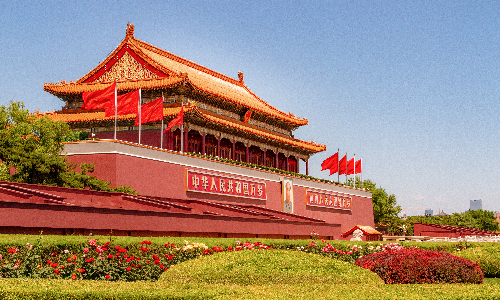
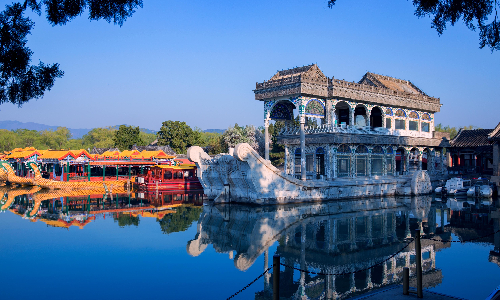
Today, your tour in Beijing will continue. After breakfast, you will head northwest towards Ming Tombs, about 45 kilometers away from the city center. It will be a 1.5-hour drive. The Ming Tombs, with an area of 120,000 kilometers, are the general name of the royal tombs of the 13 emperors in the Ming Dynasty. When you come here, you will visit the Ding Tomb of the Ming Tombs, the tomb of Zhu Yijun, who is the 13th emperor of the Ming Dynasty. Covering an area of 182,000 square meters, the Ding Tomb of the Ming Tombs is the only tomb that has been excavated among the 13 tombs. Its construction started in 1584 and was completed in 6 years. As the main part of the Ding Tomb, the underground palace is 27 meters deep and consists of five halls, with a construction area of 1195 square meters. Among the five halls, the halls on the left and right sides are symmetrical. In the middle of the two halls, there is a coffin platform made of white marble respectively.
After lunch, you will visit Mutianyu Great Wall, about 45 kilometers away from the Ming Tombs. You will drive northeast for about one hour to get there. As the longest section of the Great Wall in China, Mutianyu Great Wall is 5,400 meters long. It is the essence of the Great Wall of the Ming Dynasty. This tourist attraction is equipped with a domestic advanced cable car for ascending this Great Wall. What’s more, you can also choose to take chairlift to ascend the wall and take toboggan down (For the sake of tourists' safety, people over 60 are not allowed to take toboggan).
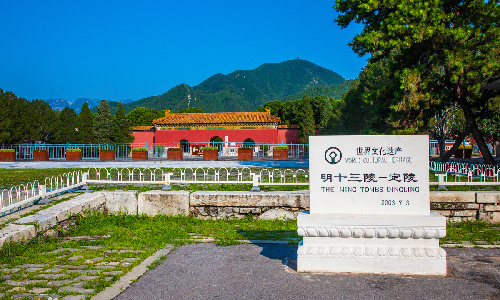
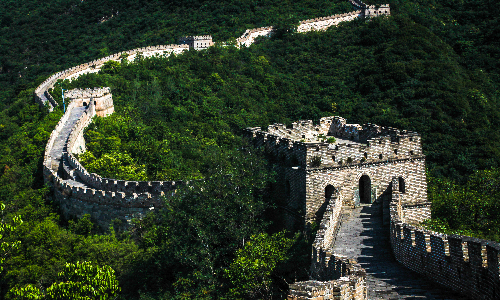
 Xi’an
Xi’an Today is the last day of your tour in Beijing. In the morning, you will visit Hutong, which is the best way for you to learn more about the history of Beijing. Hutong originates from the Yuan Dynasty when its capital was founded in Beijing in 1267 and has a history of more than 700 years. From these quadrangle courtyards in big or small Hutongs, you can learn about the life of Beijing residents, including their lifestyle and neighborhood relationships. There are many ways to name Hutongs in Beijing. Like the wide Hutong, people call it “Kuan street”(kuan means wide), the oblique one “Xie street”(xie means oblique). You can take a rickshaw to visit these Hutongs and go to one of quadrangle courtyards to talk with local people.
After leaving Hutongs, you will be transferred to the train station. And in the afternoon, you will take the estimated train G57 14:00/18:24 to Xi’an in northwestern China. According to your train timetable, our tour guide in Xi’an will be waiting for you. And then you will be transferred to the hotel to have a good rest. Your Xi’an tour 2022 will begin tomorrow. Xi’an, the capital of Shaanxi Province, covers an area of 10,108 square kilometers. According to the seventh census data, as of November 1, 2020, the permanent population of Xi'an was 12,952,907. In Xi’an, winter is cold, windy, and foggy, while summer is hot and rainy. That means the four seasons here are distinct. Tomorrow, with the company of our tour guide, you will explore the beauty and charm of Xi’an.
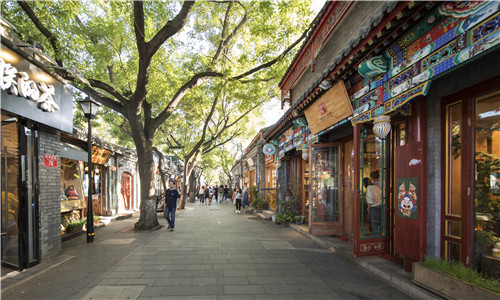
Your tour in Xi’an will formally begin today. After breakfast, you will head northeast towards Terracotta Warriors and Horses Museum in the Lintong District. You will drive for about 50 minutes to visit this tourist attraction, 45 kilometers away from the downtown. Terracotta Warriors and Horses Museum is one of the world wonders. After Emperor Qin Shihuang, the first emperor in Chinese history, took the throne at the age of 13, he began to build his tomb secretly. There are three large burial pits of terracotta warriors and horses that have been excavated, with a total area of 22,780 square meters. Most of the terracotta warriors used to hold bronze weapons, including bows, crossbows, arrowheads, spears, and words. Although these bronze weapons have been buried in the ground for more than two thousand years, they are still as bright and sharp as new. As the Terracotta Warriors and Horses Museum is the largest ancient military museum in China, it is a good place for you to learn the military system of ancient China.
After lunch, you will go to Big Wild Goose Pagoda in the Yanta District. When it comes to Big Wild Goose Pagoda, we have to talk about Xuanzang, the eminent monk of the Tang Dynasty (618-907) and also one of the four major Buddhist scripture translators of Chinese Buddhism. In 652, to preserve the Buddhist scriptures brought back from Ancient India, Xuanzang presided over the construction of this pagoda. Through several changes of this pagoda in terms of its height and the number of its floor, now it has 7 stories, with a height of 64.517 meters. Xuanzang is dedicated to the translation of Buddhist scriptures here, which is used to collect Buddha statues and scriptures. The Big Wild Goose Pagoda, as the earliest and largest existing quartet-style brick pagoda in the Tang Dynasty, is a witness to the integration of Buddhism into Chinese culture.
After visiting Big Wild Goose Pagoda, you will go sightseeing on the Ancient City Wall in the center of Xi’an. With a height of 12 meters, the top and the bottom width of this city wall are 12 to14 meters and 15 to 18 meters respectively. The existing city wall, whose outline is a closed rectangle with a total length of 13.7 kilometers, is the building of the Ming Dynasty. And its construction started in 1370 and was completed in 1378. There are four main gates, which are also the original gates of this city wall. And many new gates were opened later. So far, there have been 18 gates on this city wall. When you come to here, you can rent a tandem (a bicycle made for two riders sitting one behind the other) to overlook the city panorama at sunset. That will be a very interesting experience for you.
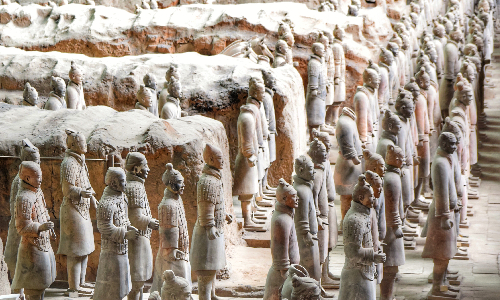
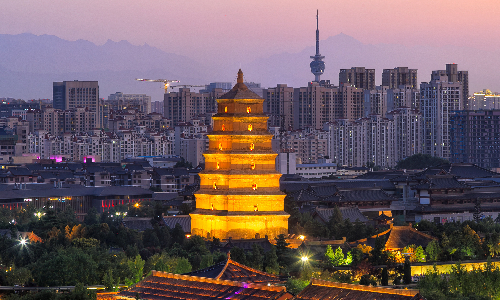
 Chengdu
Chengdu During these several days, you have enjoyed the most famous attractions in Xi’an. And today you will go to a new city to continue your tour. After breakfast, you will have some limited time to return to your room to pack luggage. Then you will be transferred to the train station to take the estimated train D1917 09:00/12:17 to Chengdu in southwestern China. When you arrive in Chengdu, our local tour guide will pick you up at the train station. Chengdu, the capital of Sichuan Province, covers an area of 14,335 square kilometers. And as of November 1, 2020, its permanent population reached 20,937,800. As for its climate, its annual average temperature is 16℃. So from March to June and from September to November are the best periods to travel in Chengdu.
After lunch, your Chengdu tour 2022 will start from the Kuan Zhai Alley in the Qingyang District. Kuan Zhai Alley is a complex cultural commercial street, which is mainly for tourism and leisure, has distinctive regional characteristics. The alley, covering an area of nearly 80 acres, starts from Zhijishi Street in the north, Jinhe Street in the south, Changshun Street in the east, and Tongren Road in the west. There is a Kuan Alley and a Zhai Alley which are about 7 meters and 5 meters wide respectively. If you want to experience the authentic Chengdu life, you should go to the Kuan Alley, which was named Xingren Hutong during the reign of Emperor Xuantong (the last emperor of Chinese history). There are many buildings of the late Qing Dynasty and the early Republic period, including some Western-style buildings left by the church. If you’re tired, you can sit on a bamboo chair and take a cup of tea, making you more pleased.
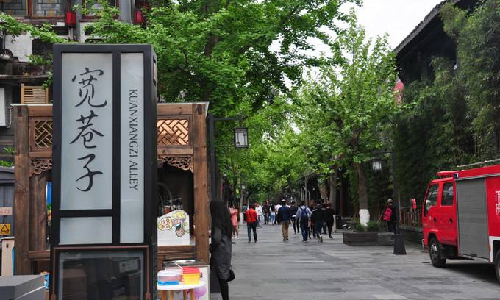
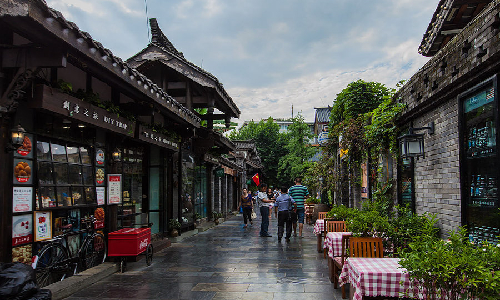
If you go sightseeing in Chengdu, you can’t miss visiting giant pandas. We have arranged a panda sightseeing tour for you. After breakfast, you will go to the Chengdu Research Base of Giant Panda Breeding in Chenghua District. This research base is a well-known conservation and research institution for giant pandas and other rare and endangered wild animals. Simultaneously, it has established education facilities including the Giant Panda Museum, which opened to the public in 1992. In the Giant Panda Museum, you will see three exhibition areas, with a total area of 3,000 square meters. Moreover, you can also visit the Giant Panda Kitchen, displaying a variety of giant pandas’ edible bamboo and fruits. You can choose to taste the food offered to giant pandas, which is a fantastic experience.
After leaving Chengdu Research Base of Giant Panda Breeding, you will visit Du Fu Thatched Cottage in Qingyang District. When it comes to Du Fu Thatched Cottage, we should learn about Du Fu first. Du Fu is a famous poet of the Tang Dynasty. In the winter of 759, to avoid the Anshi Rebellion, a civil war of the Tang Dynasty for power, Du Fu came to Chengdu from Longyou (now southern Gansu Province) with his family. Du Fu Thatched Cottage is the place where he lived with his family. Based on the description of Du Fu’s poems, his former residence was restored and reconstructed. Covering an area of 45 acres, today Du Fu Thatched Cottage has evolved into a well-known cultural sacred place that integrates the memorial ancestral hall and Du Fu’s former residence. When you come here, you will have a chance to visit more than 30,000 volumes of materials and 2,000 cultural relics, including block-printed editions, photocopies, manuscripts, and various modern printed copies of Du Fu’s classic.
After lunch, you will visit Chengdu Wuhou Shrine Museum in Wuhou District. Covering an area of 150,000 square meters, Chengdu Wuhou Shrine Museum was built in 221. It was originally a special shrine to commemorate Zhuge Liang, who was a famous politician, military strategist, writer, and inventor in the Three Kingdoms Period (220-280). Later it became a place for the sacrifice to both Zhuge Liang and Liu Bei. Liu Bei was the emperor of Shuhan Kingdom (one of the kingdoms in the Three Kingdoms). There is an impressive story between Liu Bei and Zhuge Liang. Liu Bei heard that Zhuge Liang was knowledgeable, so he hoped Zhuge Liang can assist him. From 206 AD to 207 AD, Liu Bei visited Zhuge Liang three times, bringing many gifts. And in the last time, when Liu Bei came, Zhuge Liang was sleeping. So Liu Bei stood outside Zhuge Liang’s house until he woke up. Finally, Zhuge Liang assisted Liu Bei loyally to found the Shuhan Kingdom.
When you finish your sightseeing in Chengdu Wuhou Shrine Museum, you will visit Jinli Street. Jinli Street, with a height of 550 meters, integrates tourism, shopping, leisure, and entertainment. It covers an area of more than 30,000 square meters, with a construction area of more than 14,000 square meters. According to legend, Jinli Street was once one of the oldest and most commercial streets in the history of Shuhan Kingdom. There are various performances on this ancient street, including traditional weddings, folk music, drama, folk costume shows, and other folk performances. What’s more, there are also special themed activities following traditional Chinese festivals. If you visit Jinli Street, you will have a chance to participate in these activities, which will help you enjoy the cultural atmosphere of Sichuan comfortably.
Tomorrow your Chengdu tour 2022 will continue, you will explore more interesting places.
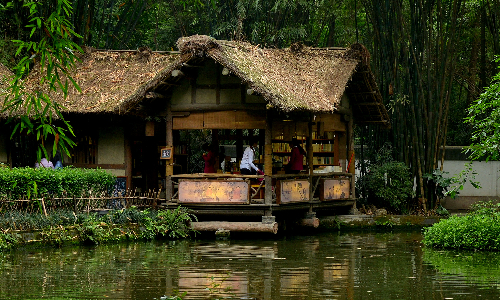
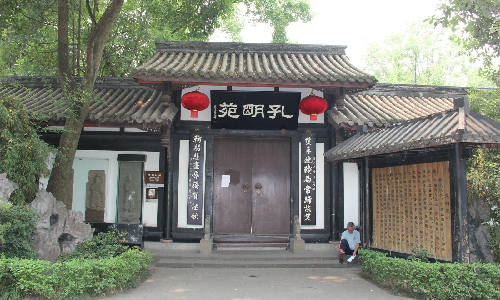
After a hearty breakfast, you will drive southwest for about 2 hours to Leshan Giant Buddha, 166 kilometers away from the city center of Chengdu. Leshan Giant Buddha is a sitting stone carving of Maitreya. It is 71 meters high, making it the biggest stone carving in China. This place, in ancient times, was a place where three rivers converged. The water was quite fierce, and ships were often subverted. In summer, because of plenty of rain, the water often caused tragedies of ship destruction and death. To reduce the harm of the water and to bring all living beings out, a Chan master (honorific title for a Buddhist monk) recruited people and collected material resources to build Leshan Giant Buddha. It took 90 years to complete. When visiting, you will find that this Buddha statue is as tall as the mountain behind it. What’s more, he has a proportioned shape and his hands are putting on his knees. All of these make him looked magnificent.
After lunch, you will head northeast towards Huanglongxi Ancient Town, about 160 kilometers away from Leshan Giant Buddha. You will take a 2-hour drive to get there. With a history of more than 1,700 years, Huanglongxi Ancient Town is a tourism-oriented town based on agriculture. With beautiful scenery, this ancient town is a well-known natural film and television shooting base at home and abroad. It’s mainly featured by ancient streets, trees, temples, and primitive folk customs. There are three famous ancient temples, including Zhenjiang Temple, Gulong Temple, and Chaoyin Temple. Gulong Temple, the earliest temple built in Huanglongxi Ancient Town, with ancient stages and ancient banyan trees. On the main entrance of this temple stands a stage called Wannian Stage. This stage, built in the early Qing Dynasty, has a history of more than 300 years. It covers an area of 103 square meters, with a height of 8 meters. You can’t miss this stage, as it is the only one of the nine stages left in the town.
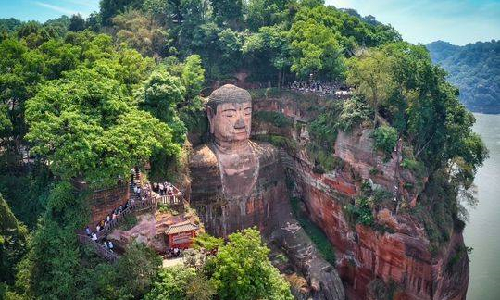
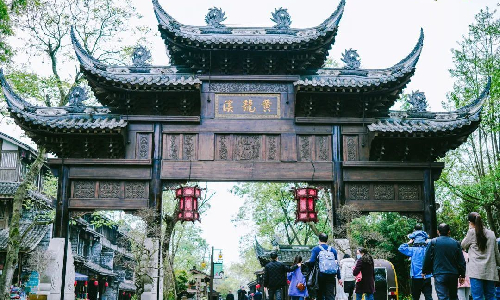
 Guilin
Guilin Your tour in Chengdu will come to an end today. After breakfast, you will go to the airport. Then you will take the estimated flight CA4323 09:10/10:55 to Guilin in the Guangxi Province. According to the flight schedule, our tour guide in Guilin will pick you up at the airport. After checking in the hotel, you can take a good break to mitigate the fatigue of your short trip. You will explore the beauty of Guilin the following day.
Today you will start your tour in Guilin. In the morning, you will head southeast towards Mopanshan Wharf, 35 kilometers away from Guilin. It will take you a one-hour drive to get to that wharf. As soon as you arrive at Mopanshan Wharf, you will take the Li River Cruise, traveling from Guilin to Yangshuo. As this trip will last 4 hours, you will have lunch on the cruise, appreciating the beautiful scenery of both sides. Along this trip, you will see the Nine Horses Painting Mountain. As its name implies, there are nine horses can be seen on this mountain. There are many legends about this mountain. Legend has it that in ancient times, only the Number One Scholar could recognize all the 9 horses, while ordinary people could only recognize 4 or 5 horses. You can have a try here.
In the afternoon, you will go to Yangshuo West Street, a pedestrian street in the center of Yangshuo. Yangshuo West Street, which runs from east to west, is about 8 meters wide and nearly 800 meters long. With a history of more than 1400 years, it is the oldest and most prosperous street in Yangshuo. We can see many ancient buildings here such as city walls of the Ming Dynasty, inscriptions, ancient temples, and former residences of celebrities. And some houses on this street retain the features of the buildings in the Ming and Qing Dynasties, while the bars and cafes on both sides are in European style. It is an ideal place for Chinese to learn foreign languages and foreigners to learn Chinese. As long as you can say “Hello”, “Good morning” or other polite words in Chinese, you will quickly make a friend. This street is a fine place for you to experience the integration of Chinese and Western cultures.
After visiting Yangshuo West Street, you will be transferred to Guilin, where you will check in at the hotel. What you need to do is to have a good rest, so you will be energetic tomorrow.
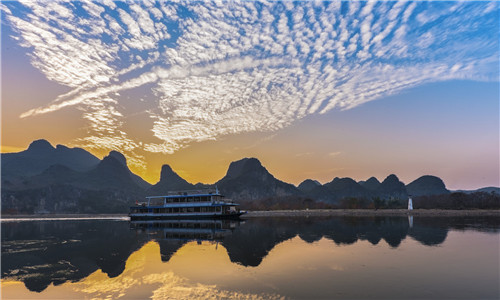
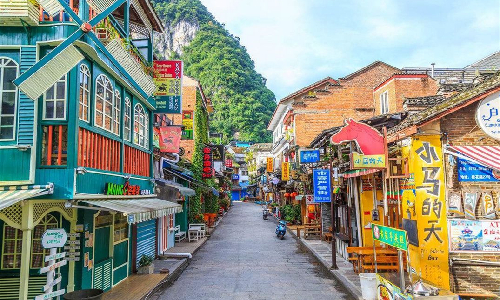
 Lijiang
Lijiang Your tour in Guilin will be over today. After breakfast, you should bring your luggage to the lobby of the hotel on time. Then you will be transferred to the airport to take the estimated flight MF8635 10:40/12:35 to Lijiang, a world-famous city for its tourism in Yunnan Province. As soon as you arrive at the airport, our local tour guide will pick you up. Accompanied by our tour guide, your Yunnan tour 2022 will begin tomorrow.
Today your tour in Lijiang will formally begin. After breakfast, you will go to Tiger Leaping Gorge, about 80 kilometers away from the downtown of Lijiang. And you will drive northwest for 1.3 hours to get to Tiger Leaping Gorge. Located in the upper reaches of the Jinsha River, Tiger Leaping Gorge is divided into three parts, with a total length of 17 kilometers. It is between Jade Dragon Snow Mountain and Haba Snow Mountain. With a difference in height of 3,900 meters, Tiger Leaping Gorge is one of the deepest gorges in the world. There is a legend about Tiger Leaping Gorge. In the past, the ruler of Lijiang was very rich. One day, he rode his tiger along the Jinsha River. When they arrived in a relatively narrow area, the tiger leaped forward and jumped onto a big rock in the middle of the river. But the ruler fell into the billowy water. So when you come here, you will find that there is a giant stone. Legend has it that this stone was transformed by a tiger in order to find its owner here.
Then, your next stop is the First Bend of Yangtze River in Shigu Town. The First Bend of Yangtze River is 1,850 meters above sea level. The Yangtze River, which rushes down from Qinghai-Tibet Plateau, enters Yunnan Province from Batang County. Then it, along with Lancang River and Nu River, suddenly turns northeast in Shasongbi Village, forming a “V”-shaped bend. Thus people call it the First Bend of Yangtze River. Local folklore has it that Nu River, Lancang River, and Jinsha River (also known as the upper reaches of the Yangtze River) are three sisters. One day, they decided to travel together, but they were in dispute during the trip. Then the eldest sister and the second sister went south. The little sister, Jinsha River, was determined to find love in the east. So after arriving in Shigu County, she suddenly turned and headed towards the east. The place where the Jinsha River turned around is the First Bend of Yangtze River.
After visiting the First Bend of Yangtze River, you will return to Lijiang to visit Lijiang Ancient Town, built in the late Song Dynasty (960-1279). Lijiang Ancient Town, with an area of 7.279 square kilometers, is located in the middle of Lijiang Bazi (partial plains on the plateau), on the Yunnan-Guizhou Plateau. There are many tourist attractions here. For example, Xu Xiake Memorial Hall in the Old Town stands in the Guangyi Community. Xu Xiake is a famous geographer, traveler, and writer in the Ming Dynasty. And after 30 years of investigation, he wrote a 600,000-character geography masterpiece, the travels of Xu Xiake. In 1639, Xu Xiake traveled southwest to Lijiang to verify the source of the Yangtze River. During the 16-day sightseeing in Lijiang, he experienced the local customs deeply. To showcase this precious history and inherit the profound friendship between Xu Xiake and Lijiang, the Xu Xiake Memorial Hall in the Old Town was constructed.
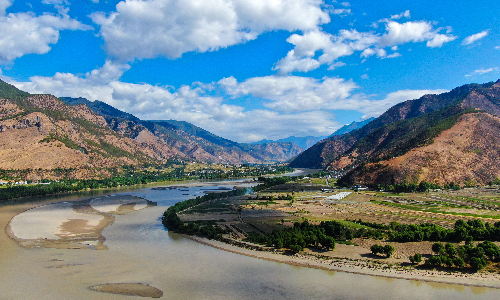
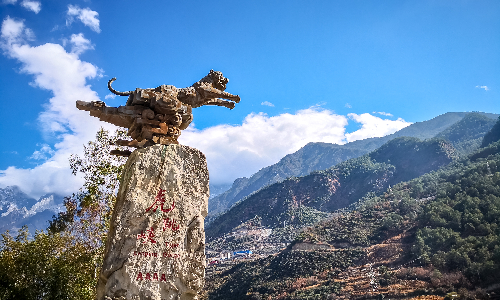
 Dali
Dali After breakfast, you will head northeast towards Jade Dragon Snow Mountain, 36 kilometers away from the downtown of Lijiang. You will take a 50-minute drive to get to that place. Jade Dragon Snow Mountain in Lijiang is the largest snow mountain in the southernmost Northern Hemisphere. It is 35 kilometers long from north to south and 13 kilometers wide from east to west, covering an area of 960 square kilometers. Its main peak is steep, with an altitude of 5596 meters. There is Glacier Park, a typical representative of modern glaciers in Jade Dragon Snow Mountain. It is a park composed of stone caves formed by the erosion of glaciers. Glacier Park is the best place for skiing and playing in the snow in China.
After lunch, you will go to Baisha Village in Dayan Town. Baisha Village served as Lijiang’s political, economic, and cultural center in the past. And some glorious buildings built during the Ming and Qing Dynasties, still stand here. When you come here, you will see not only these ancient buildings, but also famous Baisha Mural, with a history of more than 500 years. Baisha Mural, which serves as an integral part of Lijiang’s World Cultural Heritage, is unique for integrating religious cultures and folk arts. The religious figures depicted in the murals incorporate painters’ aesthetic thoughts and show the social life at that time. Dajibao Palace, built in1582, is a best place for you to visit Baisha Mural. The 12 murals preserved in the palace are the largest and well-preserved part of the existing murals in Lijiang.
After visiting Baisha Mural, you will go to Dali, about 195 kilometers away from Baisha Village. You will take a 2.5-hour drive towards south to get to Dali. As soon as you arrive in Dali, you will be transferred to the hotel to have a good rest. Tomorrow you will start your tour in Dali.
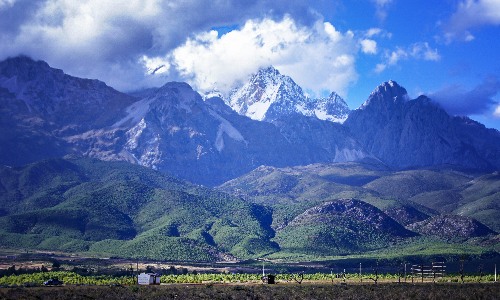
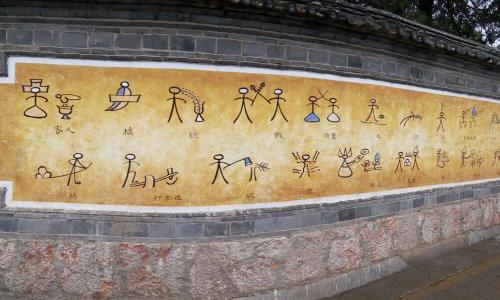
After breakfast, you will go to visit Chong Sheng Temple and Three Pagodas, which is a famous pagoda in southwest China. Chong Sheng Temple and Three Pagodas is composed of a main pagoda and two small pagodas. It has a history of 1,195 years. The main tower is also called Qianxun Pagoda. It was built in the Tang Dynasty and has a height of 69.13 meters. The two small pagodas distributed in the north and south, were built in the Song Dynasty, with a height of 42.19 meters. What’s more, since its construction, Chong Sheng Temple and Three Pagodas has gone through 30 strong earthquakes in addition to thousands of years of wind, rain and sunlight. However, it still stands there. During your trip, you can try to find some traces that earthquakes left behind.
After visiting Chong Sheng Temple and Three Pagodas, you will go to Dali Old Town, the political, economic, and cultural center of Yunnan during the Tang and Song Dynasties. The ancient town was built in 1382, covering an area of 3 square kilometers. It is about 1,000 meters wide from east to west, and about 2,000 meters long from north to south. As its moderate climate, it’s a cozy place for you to travel. There are many cultural relics and historic sites in this old town, whose structure is basically preserved. For example, Nancheng Tower, whose gate is the first of the four gates in this old town, is also called Shuanghe Tower or Chengen Tower. Built in 1382, it is the oldest and most majestic building here and serves as a symbol of Dali. The two Chinese characters “Da Li” was inscribed by Guo Moruo, a writer, historian, and archaeologist in Chinese modern times. You can come here to enjoy the beauty and history of Dali.
After lunch, you will head to Xizhou Ancient Town, 18 kilometers away from Dali. Xizhou, an important town inhabited by the Bai minority, is the best-preserved Bai residential area. In history, Xizhou was the military center of Nanzhao Kingdom (738-902). It once cultivated many celebrities from all walks of life. And in the past, the industry and commerce here were also prosperous, and it was once one of business centers in Yunnan. There is a stone memorial archway standing here, also known as Wenming Archway, built in recent years. Its original name is Timing Archway, which was built by a few scholars in the Qing Dynasty after they became government officials. At that time, all the villagers who succeeded in working as government officials were able to engrave their names on this archway.
After finishing your sightseeing in Xizhou Ancient Town, you will go to visit Erhai in the suburb of Dali. Erhai, which starts from Eryuan County in the north, is about 42.58 kilometers long. And it has a maximum width of 9.0 kilometers from east to west, covering an area of 256.5 square kilometers. Looking down from the sky, Erhai is like a crescent moon, lying quietly between Cangshan Mountain and Dali Bazi. We have arranged a boat tour for you. So you can appreciate its beautiful scenery by boat. There is a legend about Erhai. When an emperor’s daughter had just married, her husband took part in a war. After more than a decade, her husband never came back. And soldiers, who had gone home, said that her husband was dead. The princess, who was in great sorrow, began to cry day and night. Eventually Erhai appeared which was full of her tears.
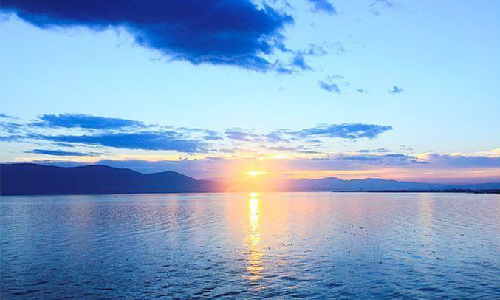
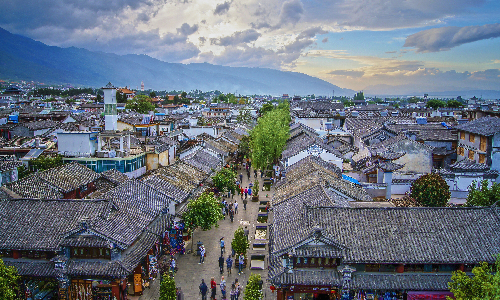
 Kunming
Kunming oday you will go to Kunming, the capital of Yunnan Province. You should get up early and eat breakfast. Then you will be transferred to the train station to take the estimated train D8662 08:22/10:43 to Kunming.
Upon your arrival, our local tour guide will be waiting for you at the train station. Then you will head southeast towards Stone Forest, about 85 kilometers away from the train station. It will be a 1.2-hour drive to get to this tourist attraction. Stone Forest has been appraised as “World Geopark” by the UNESCO (The United Nations Educational, Scientific and Cultural Organization). There are many places worth being visited. For example, the Major Stone Forest is composed of dense stone peaks. And the tallest independent stone peak here is more than 40 meters high. Except for visiting the stone forest here, you can also appreciate some precious plants and animals that you can rarely see, including red chrysanthemum, Yunnan camphor wood, pangolin, and civet cat.
After visiting Stone Forest, you will return to the downtown of Kunming. And you will check in the hotel to take a good rest. Tomorrow, you will go to Shanghai to continue your tour.
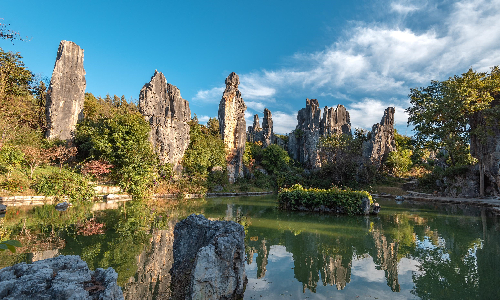
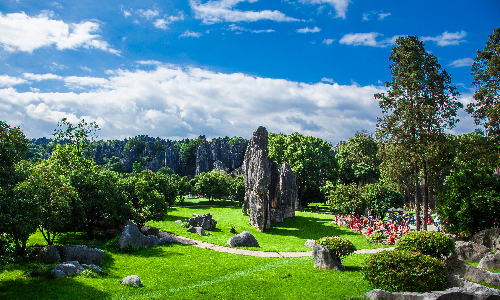
 Shanghai
Shanghai This morning you will leave Kunming for Shanghai, an international metropolis. You will be transferred to the airport to take the estimated flight MU5803 9:00/11:55. As soon as you arrive in Shanghai, our tour guide will wait for you at the airport. Then you will go to the hotel to have a break. You can choose to stay at the hotel or go for a walk outside. Tomorrow you will visit some tourist attractions of Shanghai.
Free Time Suggestion:
In the afternoon, if you don’t want to stay at the hotel, you can go to Tianzifang Market in Huangpu District. Tianzifang Market is actually the name given to this old alley by the painter Huang Yongyu a few years ago. In addition to creative shops, galleries, and photography exhibitions, Tianzifang Market is filled with various cafes. In the idle afternoon, you can go to a café to drink a cup of coffee, reading books or just sitting quietly. It will make you feel comfortable and pleased, away from the hustle and bustle of the city. Moreover, a five-story factory building here has been converted into an urban industrial building. Covering an area of 5,000 square meters, it has attracted artists from 10 countries. In front of the entrance, there are 10 flagpoles with 10 flags of different countries flying, like a small international art fair, with the Chinese and Western cultures blending here.
This day, you will go sightseeing in Shanghai, an international metropolis. After breakfast, you will go to Jade Buddha Temple in Putuo District. As this temple mainly enshrines two jade Buddha statues, it is known as Jade Buddha Temple. The Jade Buddha Temple, which imitates the building of the Song Dynasty, covers an area of about 7700 square meters, with a total building area of 8856 square meters. There is a building called Jade Buddha Tower, where a sitting jade Buddha is enshrined. This sitting Buddha statue, with a height of 1.95 meters, is carved from a whole piece of jade. The Buddha’s face is plump; his eyebrows are like crescent moons. This Buddha statue, which is decorated with more than one hundred emeralds and other gems, is exquisitely carved. Moreover, there are also many precious Buddhist classics and cultural relics in the Jade Buddha Temple. For example, there is a collection of Tripitaka, an extremely precious Buddhist scripture.
After visiting Jade Buddha Temple, your next stop is Yu Garden (closed each Monday) in Huangpu District. Yu Garden, a classical garden in southern China, with a history of more than 400 years. It was originally a private garden and was built by Pan Yunduan, a government official in the Ming Dynasty. To provide a comfortable and beautiful living area for his father in his old age, Pan Yunduan started to build Yu Garden. So this garden was called Yu Garden, because the Chinese character “yu” means peace and tranquility. But before completing its construction, Pan Yunduan’s father died. In the Sansuitang Scenic Area in the garden, there is an inscription stone, which was written by President Jiang Zenmin in 1999 to commemorate the 440th anniversary of Yu Garden.
In the afternoon, you will go to Shanghai Tower, a landmark building located in Pudong New Area. Shanghai Tower has 127 floors above ground, with a total height of 632 meters. Its exterior is spiraling upward, looking like the shape of the traditional Chinese dragon. Shanghai Tower hosts art exhibitions and audio-visual performances sometimes. Its 119th, 125th and 126th floors have sightseeing areas. Souvenir shops are set up on the sightseeing platforms, so you can buy some souvenirs there. What’s more, it is equipped with 106 elevators totally. Its speed can reach 18 meters per second and you just need 55 seconds to reach the 119th floor. Via these elevators, you can go to the highest point in Shanghai Tower, the 126th floor, with a height of 583 meters.
After leaving Shanghai Tower, you will visit The Bund, which is located on the bank of Huangpu River. With a total length of about 1.5 kilometers, the Bund is a famous tourist attraction in Shanghai. There are 52 classical revival buildings with different styles on the Bund, known as the Bund des Nations Building Expo Group. One of the landmarks of the Bund, and a building of national importance here, is the Xujiahui Observatory, which was established in 1884 by the French Catholic Church as a meteorological signal station on the Bund. This meteorological signal station was originally a long wooden pole standing straight up in the ground. In 1907, it was rebuilt as a cylindrical building, with a height of 50 meters. This was one of the earliest meteorological signal stations in China.
As soon as you finish your sightseeing in the Bund, you will go to Nanjing Road, the last stop today. Nanjing Road serves as a commercial pedestrian street at home and abroad. It covers an area of about 30,000 square meters, with a length of 1,033 meters. There are many public facilities, such as chairs, street lights, telephone booths, and shopping kiosks. It is known as “the No.1 commercial street in China” and it has witnessed the changes of the large city. What’s more, there are various shopping malls, famous landmarks, and time-honored shops, where you can feel the charm of the modern city, take some beautiful photos and buy some clothes and local food. For example, you can go to Shaowansheng Food Company. It is a food company with a history of 156 years, which is known for its Shaola (a kind of roast meat) and Zaozui (aquatic products marinated in alcohol and other secret ingredients). You can not only taste but also buy and take the delicious and special local food back home and share them with your families and friends. Shanghai Laodatong Shandao Rice Shop is another interesting shop that deserves to visit. It sells everything about rice, for example, ice cream and hand cream made by rice.
After visiting Nanjing Road, your Shanghai tour 2022 will come to an end.
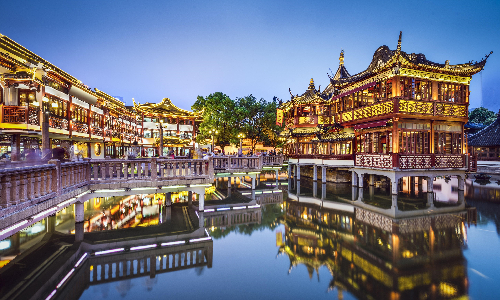
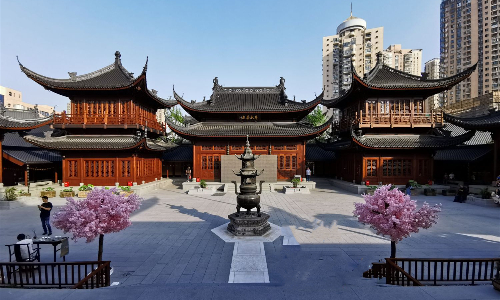
Your China tour 2022 from Beijing to Shanghai today will come to an end. It’s time to say goodbye. After breakfast, you can pack your luggage. And then based on your flight schedule, you will be transferred to the airport. We hope you really have a good time during the 18-day tour. And welcome you to visit China again.
Editor: Deng Kaili
Proofreader: Summer Hou
| City | Five Star hotel list | Four Star hotel list |
|---|---|---|
| Beijing | Sunworld Dynasty Hotel Beijing Wangfujing | Sunworld Hotel Wangfujing |
| Xi'an | Tianyu Gloria Grand Hotel Xi'an | Sunworld Dynasty Hotel |
| Chengdu | Sofitel Chengdu Taihe | Holiday Inn Express Chengdu Jinniu |
| Guilin | Lijiang Waterfall Hotel | Guilin Bravo Hotel |
| Lijiang | Wonderport International Hotel | Lijiang Wangfu Hotel |
| Dali | The One Hotels & Resorts | Landscape Hotel |
| Kunming | Grand Park Kunming | UChoice Hotel |
| Shanghai | Ocean Hotel Shanghai | Ambassador Hotel |
 |
![]() About your child or infant, please contact us for a discounted price.
About your child or infant, please contact us for a discounted price.



We started with a few days in Beijing & ended in Shanghai, from where we visited the Forbidden City and Great Wall. In between we visited Terra Cotta Warriors Museum, Panda Base, Shanghai Disneyland.

We had a wonderful holiday in China which will remain long in the memory. China is a breathtakingly beautiful country full of splendid temples and palaces, mountains and rivers, peaceful rural scenes and bustling shopping streets.
 QUICK ENQUIRY
QUICK ENQUIRY